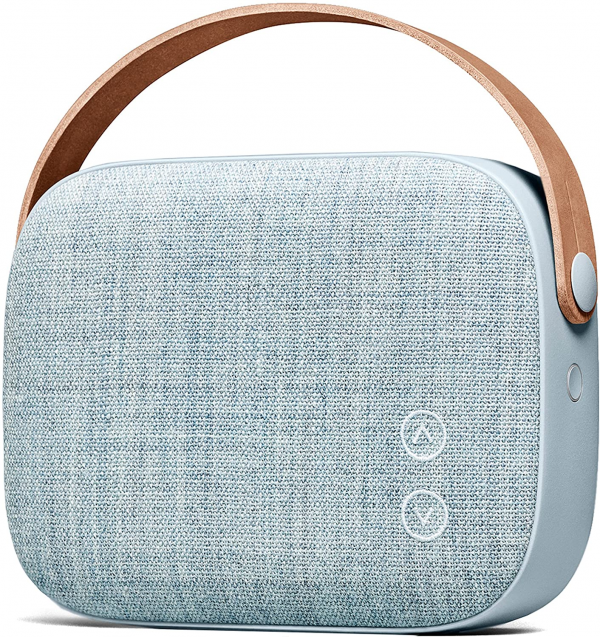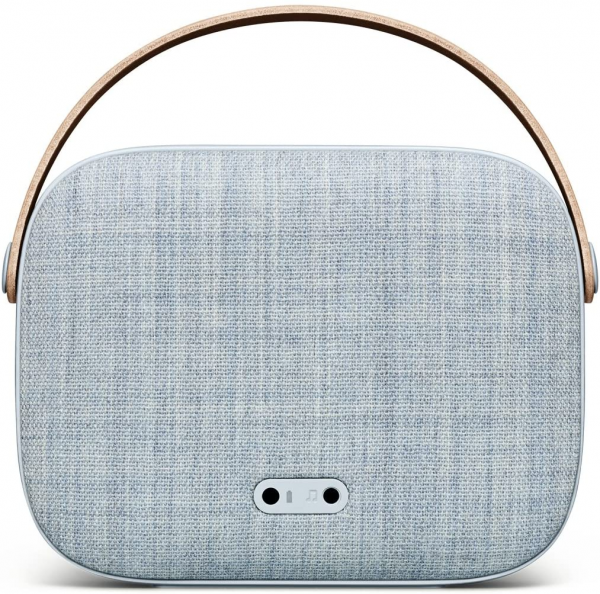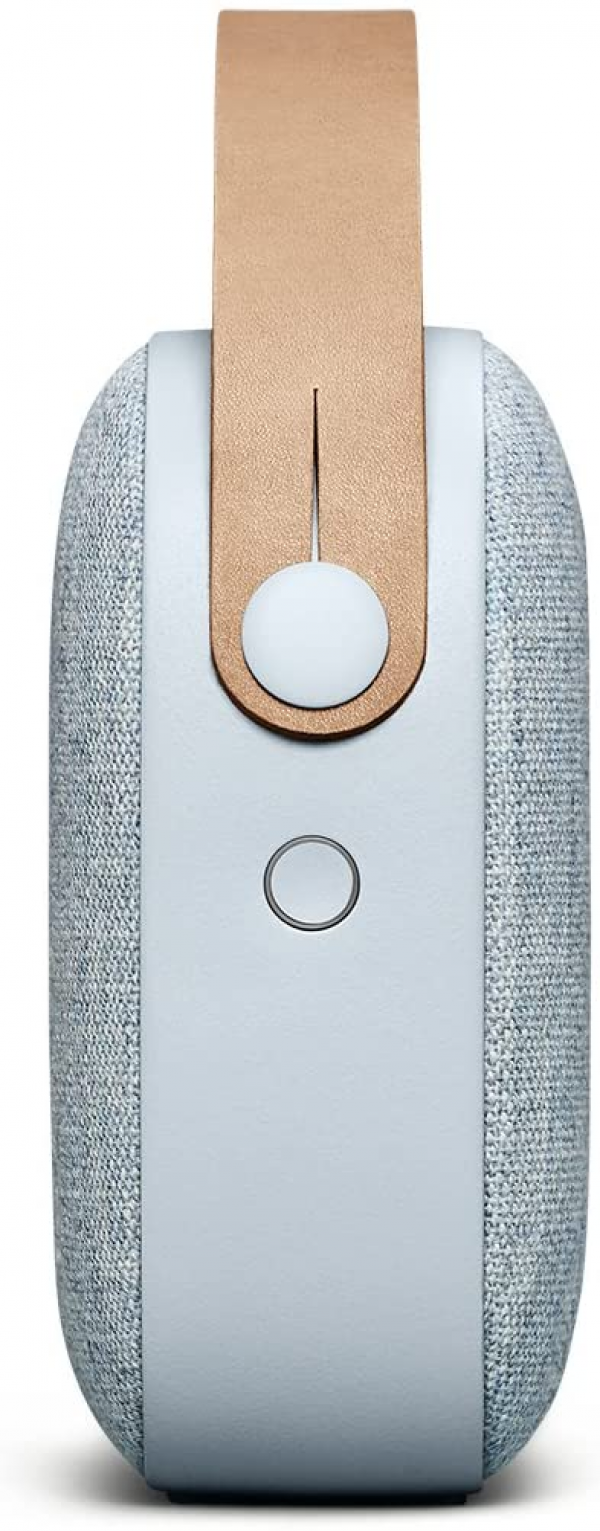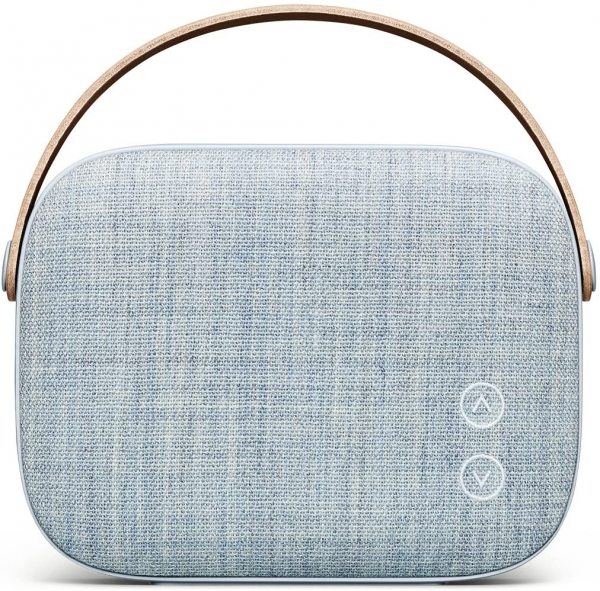Vifa
Vifa Helsinki: simplicity in its purest form
Aprox. 399€ - see price -
See specificationsVifa is a Danish speaker manufacturer that has been around for many years but is still little known to the general public. We are opening the test ball for this brand with its most accessible product, a portable speaker but designed to stay at home: the aptly named Helsinki. Vifa is intended for music lovers who want to own an object that is at once beautiful, discreet, compact and above all efficient. Let's see that ...
Positive points
Overall well balanced.
Well-defined and rich voices.
Relatively warm and deep bass considering the size.
Power.
Very careful construction and design.
Easy pairing / NFC chip.
Low Bluetooth latency.
Bad points
A little too pronounced Sibilance
Its narrow, not very diffuse.
A single light indication and not always visible.
Very unstable application.
No USB for recharging.
Report autonomy / size a little fair.
Weight.
Our review
Ergonomics
Helsinki comes in the form of a small, sleek and minimalist handbag. It consists of a single piece of metal, two grids covered with Kvadrat textile, an ultra-rigid plastic cover and a small strap in real leather. If everyone is free to appreciate the design, we can only salute the quality of the materials and the assembly - made in Denmark.
The enclosure does not show any assembly marks and benefits from a very good general solidity. In addition, the aesthetic work from which it benefits allows it to be accommodated quite harmoniously in an interior decoration. The price to pay is a relatively high weight, because this beautiful baby still weighs 1.48 kg. This model is clearly intended for sedentary use, even if it can be moved from time to time in the house or in the garden, for example, thanks to the integrated battery. A large pocket is provided for storing the speaker and its cables, which helps protect it when placed in a backpack or suitcase.
As is often the case with this type of minimalist design, the possibilities of control and aids to use are reduced to the absolute minimum. The Helsinki has only 3 buttons: two discreetly placed on the front that allow you to control the volume, and a last on the right side for switching on, pairing and choosing the source. It therefore does not allow you to navigate between tracks or stop or resume reading. Simplistic to the end, only a light indication on the side provides information on the status of the pairing, the selected source or the dry battery. We would have appreciated sound aids to mark the stages of pairing, to indicate when the sound level min./max. is reached or to signal a low battery level. Apart from that, the Vifa Helsinki is easy to connect via Bluetooth (aptX, SBC) and it has an NFC chip for compatible devices. However, we noted a small annoying detail that forces the user to restart the pairing via the device each time the speaker is turned off and on again.
All Vifa speakers of this generation are accompanied by a mobile application. Unfortunately, it is not yet developed and it detects the speaker very poorly. After five attempts, we were finally able to use it properly, but had to repeat the process a few days later. This application does not add much in terms of ergonomics, if it is not a very summary indication on the autonomy of the battery and the adjustment of the light intensity of the led. It is on the sound level that the application is most interesting, because it offers two sound options: the first applies a frequency correction if you place the speaker on a desk-type surface; the second also corrects the frequency response of the speaker, this time in case of low noise level. We will come back to their interest in sound analysis.
The Helsinki comes with a power cable with several adapters and a long mini-jack to mini-jack 3.5 mm cable to connect the speaker by wire. In view of the space available at the back, we could have imagined a USB port for charging a mobile device, but nothing is present. We understand better why once the autonomy measured: only 7:32 (volume adjusted for comfortable listening in a room of about 25 m²). It's a bit for a speaker of this size.

Audio
The Vifa Helsinki is heavily armed. It has two 50 mm full-range speakers, 2 60 mm speakers dedicated to bass mounted in push-pull (back to back) supported by 2 passive radiators. The Danish manufacturer promises a frequency response between 58 Hz and 18 kHz (± 3 dB) as well as a power of 50 W.
In practice, it offers a generally balanced sound rendering with a slight emphasis on the mids, well-defined voices and a warm bass. The bass drops relatively low, even if we expected more depth given the manufacturer's announcement. This register is reproduced in a fairly natural way while bringing a little warm side. The high-mid / treble are a little deeper, which places guitars or brass, for example, a little behind. There is a bit of aggressiveness on the cymbals and whistling, especially when you push the speaker to high sound levels. This is due to a small distortion peak, located between 7 and 8 kHz. Overall, Helsinki is fairly precise, even if the bass deserves a little more punch.
On the other hand, the scene is narrow and really lacks scope; a little as if the sound was retained inside the enclosure. The phenomenon is particularly obvious with songs very rich in sources and well compressed. In addition, stereo is limited to the edges of the speaker and the directivity is particularly pronounced towards the front. It is necessary to place the speaker well in front of the listening point to benefit from the most homogeneous rendering.
The proposed equalization modes offer 4 different configurations: neutral without compensation for table placement, neutral with compensation, low level listening without compensation and low level listening with compensation. They allow you to orient the rendering in an interesting way for the bass, much less for the treble. The placement compensation acts directly on the low / low-mid range below 400 Hz, which makes it possible to limit the sound box effect of a piece of furniture. The Late Night mode allows you to adapt listening at low levels and compensates by increasing both the frequency band before 400 Hz and after 1.5 kHz. This compensation tries to follow the loudness curve, even if we must admit that the boost should have been much softer after 1.5 kHz. To put it simply, human hearing is more sensitive to midrange (which corresponds to voice) and much less in the lowest and highest frequencies. It therefore more easily picks up the mid frequencies at low levels, but it needs a lot more power to perceive the bass and treble at the same level.
The Vifa Helsinki shows great power, which allows listening at a very reasonable level of listening indoors and outdoors, without pushing it to its limits. And that's good, because the bass tends to be more confused and the peak of distortion between 7 and 8 kHz becomes particularly annoying.
Finally, the communication latency in Bluetooth is relatively low (150 ms). There is no significant difference between the sound and the image.

Conclusion
Even if it combines certain characteristics of nomadic speakers, the very design of the Vifa Helsinki clearly limits it to sedentary use. This speaker is made in compromise and it will appeal above all to music lovers in search of a discreet indoor speaker very well built for a quality listening, but not ultimate.

Specifications
Reviews


Amazing speaker with excellent clarity along with perfect fit and finish.
Amazing speaker with excellent clarity. I cannot believe the crystal clear sound that this speaker produces. Huge quality in a small package.
It has good looks to boot. For example I now can hear back ground effects that are not there with my other speakers. I especially like the night
time listerning mode. One thing for sure it's obvious alot of thought was put into the fit and finish by Vifa. Even the packaging is first rate.
Now I know what the family members are getting for Christmas!
Update 2/6/2017 Well could not live with just one so got one in willow green for the summer home. They still are number one carry around
The soun truly is Awsome!
Love the style
Got this for my wife birthday. Now she carry this around the house and to the park. Bluetooth connection is a breeze. Love the style.
Super clear sound!
Bought this as a present for my Dad after seeing some YouTube reviews. Really impressed with the sound quality! If you are looking for crisp, balanced sound ... this is the speaker for you. It's definitely not the loudest Bluetooth speaker I've heard, but it's loud enough for most normal uses. It's not cheap ... but I'd highly recommend.